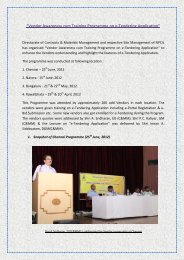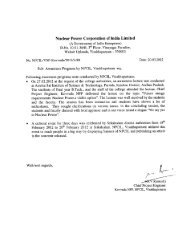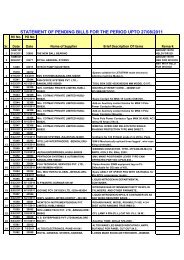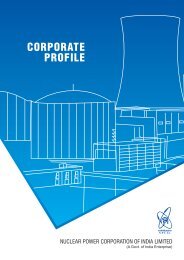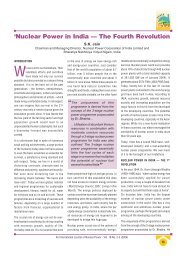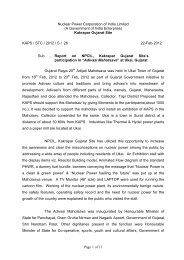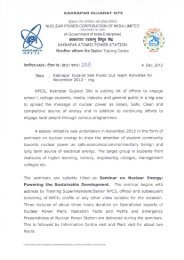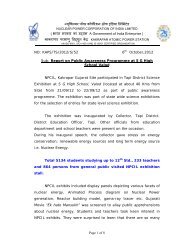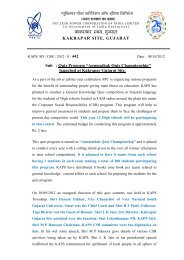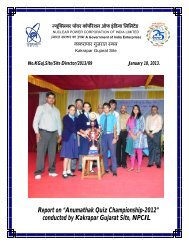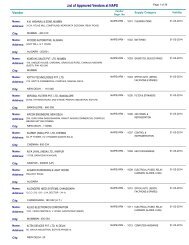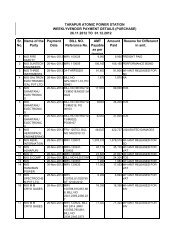Task Force Report of Standard PHWR - Nuclear Power Corporation ...
Task Force Report of Standard PHWR - Nuclear Power Corporation ...
Task Force Report of Standard PHWR - Nuclear Power Corporation ...
You also want an ePaper? Increase the reach of your titles
YUMPU automatically turns print PDFs into web optimized ePapers that Google loves.
A4<br />
SAFETY EVALUATION<br />
OF INDIAN NUCLEAR POWER PLANTS<br />
STANDARD INDIAN PRESSURIZED HEAVY WATER REACTOR<br />
(I<strong>PHWR</strong>)
SAFETY EVALUATION OF INDIAN NUCLEAR POWER PLANTS<br />
STANDARD INDIAN PRESSURIZED HEAVY WATER REACTOR (I<strong>PHWR</strong>)<br />
1.0 INTRODUCTION<br />
The safety assessment <strong>of</strong> <strong>Standard</strong> Indian Pressurized Heavy Water Reactor (I<strong>PHWR</strong>)<br />
units (220 MWe & 540 MWe) was taken up by the <strong>Task</strong> <strong>Force</strong> constituted by CMD, NPCIL vide<br />
Office Order No. NPCIL/CMD/COM/03/2011 dated 15.3.2011 to review the design features <strong>of</strong><br />
I<strong>PHWR</strong>s to ensure core cooling in view <strong>of</strong> the recent accident, earthquake followed by tsunami<br />
at Fukushima <strong>Nuclear</strong> <strong>Power</strong> Plant in Japan on 11-03-2011.<br />
I<strong>PHWR</strong> is the standardized design, indigenously designed, developed and implemented<br />
progressively at NAPS1&2, KAPS1&2, KGS1-4, RAPS-3-6 and TAPP3&4. Of these, NAPS 1&2,<br />
KAPS 1&2, KGS 1-4 and RAPS 3-6 are 220 MWe reactors, inland sites. TAPP 3&4 is 540 MWe<br />
and is a coastal site reactor.<br />
<strong>Standard</strong>ized I<strong>PHWR</strong>s are designed for external events like flood, fire and earthquake.<br />
The lessons learnt through the thorough review <strong>of</strong> the events at our stations (given below)<br />
leading to subsequent recommendations are embedded into the design after appropriate<br />
vetting by regulatory body.<br />
Fire Incident at NAPS rendering total loss <strong>of</strong> power (<strong>of</strong>f site and on site) for several hours<br />
(successfully handled on the strength <strong>of</strong> Design Provisions and appropriate Operator<br />
Actions)<br />
Flood Incident at KAPS<br />
Tsunami Incident at MAPS and TAPS<br />
The valuable feedback arising out from above led to strengthening in design as brought<br />
below:<br />
Addressing the issues related to common cause failures with respect to power supplies,<br />
pathways for cooling water supplies and strengthening the availability <strong>of</strong> heat sinks<br />
Grade level <strong>of</strong> all units is decided considering the maximum flood level w.r.t. tsunami at<br />
coastal site and possibility <strong>of</strong> dam failure for inland sites.<br />
A4:1<br />
A4
The availability <strong>of</strong> essential equipment for core cooling during postulated flood event<br />
including the location <strong>of</strong> DGs have been addressed in all the plants.<br />
The earthquake design <strong>of</strong> I<strong>PHWR</strong>s is for 0.2g (for NAPS 0.3g) acceleration during SSE<br />
condition. During the Bhuj Earthquake (7.6 Richter scale) in Gujarat, an acceleration <strong>of</strong> 0.15 g<br />
was reported at a distance <strong>of</strong> 150 km from the epicenter. During this period KAPS continued to<br />
operate. Seismic event considering the Indian seismotectonic map and estimated tsunami wave<br />
height generated on account <strong>of</strong> postulated seismic event (level <strong>of</strong> 9 on Ricther scale) due to<br />
Makran fault is less than 2 meters. Hence, both seismic and flood is not a threat for all<br />
standardized <strong>PHWR</strong> stations as these have already been considered as design input for plants<br />
or back fitted as applicable.<br />
There is a process <strong>of</strong> in depth review with respect to advances in the National and<br />
International Safety <strong>Standard</strong>s every 10 Years for all the Operating Stations as per regulatory<br />
requirements. Accordingly over a period <strong>of</strong> time all the above standardized <strong>PHWR</strong> Stations have<br />
been upgraded to latest standard <strong>of</strong> safety.<br />
In I<strong>PHWR</strong>s, core cooling is achieved by natural circulation, a complete passive system for<br />
removal <strong>of</strong> decay heat. In order to maintain natural circulation various systems backing one<br />
another are provided. Steam Generator (SG) inventory is to be replenished in order to maintain<br />
natural circulation. Hence a defense in depth approach has been used to maintain SG inventory<br />
under all possible conditions, to ensure core cooling. As the decay heat reduces with time, the<br />
requirement to replenish SG inventory also reduces.<br />
The Spent Fuel Storage Bay (SFSB), which is seismically designed, is another area where<br />
the spent fuel is being stored. The large pool <strong>of</strong> water available in it can sustain for more than a<br />
month without make up.<br />
On these strengths, the accident which occurred at Fukushima is not having<br />
implication on nuclear safety in I<strong>PHWR</strong>s .The current study has been under taken as the system<br />
<strong>of</strong> review <strong>of</strong> international events, to examine for any strengthening required with respect to the<br />
experience feedback.<br />
2.0 SCOPE AND OBJECTIVE<br />
The task force covered the intent as mentioned in the order and checked the strength<br />
and adequacy <strong>of</strong> design pathways in view <strong>of</strong> the Fukushima accident and also made a check on<br />
the availability <strong>of</strong> beyond design basis water supply pathways. The EOPs also have been visited<br />
A4:2
to check for any augmentation. On the basis <strong>of</strong> the feed back <strong>of</strong> the accident and the review,<br />
the recommendations are generated for further enhancement <strong>of</strong> the Plant Safety.<br />
3.0 EXISTING DESIGN FEATURES<br />
Existing design features for the condition <strong>of</strong> Class IV supply failures and deterministically<br />
postulated Class III supply failures are examined as given below:<br />
3.1 Class-IV <strong>Power</strong> Supply Failure<br />
In case <strong>of</strong> loss <strong>of</strong> <strong>of</strong>f site power including Class IV power, reactor shutdown is achieved<br />
automatically. Core cooling is maintained by natural circulation in Primary Heat Transport<br />
(PHT) System. Steam Generator inventory, which provides heat sink, is maintained by auxiliary<br />
boiler feed pumps (ABFPs). Alternatively Shut down cooling circuit can be valved in.<br />
Containment pressure and its cooling is maintained by normal design provisions. The ABFPs and<br />
Shut down Cooling Pumps are powered by 3x100% DGs in 220 MWe units and 4x50% DGs in<br />
540 MWe (TAPP-3,4). These DGs are tested weekly to ensure their availability when demanded.<br />
Parameters RAPP-<br />
3,4,5,6<br />
Seismic Design<br />
Limits<br />
Flood Level<br />
RL-(m)<br />
Grade Level<br />
RL-(m)<br />
Relevant site wise parameters are given in the following table.<br />
NAPS-<br />
1,2<br />
KAPS-<br />
1,2<br />
KGS-<br />
1,2,3,4<br />
0.1g 0.3g 0.2 g 0.2g 0.2g<br />
359.6 180.8 48 38.9 28.81<br />
384<br />
187<br />
51.3<br />
40<br />
A4:3<br />
TAPS-3,4 Remarks<br />
32<br />
(6.3m above<br />
MSL)<br />
(EL-m) (100) (100) (100) (100) (100)*<br />
DG<br />
Elevation(EL)<br />
100 100 100 100 100 100<br />
* protective rock<br />
bund 7.03 m<br />
above MSL in<br />
TAPP-3,4<br />
Estimated tsunami wave height generated on account <strong>of</strong> postulated seismic event (level<br />
<strong>of</strong> 9 on Ricther scale) due to Makran fault is less than 2 meters. Present elevation <strong>of</strong> DGs at<br />
TAPS-3,4 is adequately above.
3.2 Class-III <strong>Power</strong> Supply Failure<br />
Notwithstanding the above strengths, deterministically the DGs are considered not<br />
available rendering Class III power and all design pathways for cooling water supply unavailable.<br />
Continued core cooling under such Beyond Design Basis Condition is addressed through<br />
replenishment <strong>of</strong> Steam Generator (SG) Inventory by water addition through fire water system.<br />
As no power is available arrangement has been made to supply water using Diesel Driven<br />
Pumps through water supply line dedicated for the purpose. The system, water inventories and<br />
diesel oil provisions are discussed below.<br />
3.2.1 Availability <strong>of</strong> Water Inventory<br />
There are 3 nos. <strong>of</strong> Diesel Driven Fire Water Pumps available for emergency use. These<br />
pumps can supply water to SGs at 3.5 kg/cm 2 (g). Water inventory <strong>of</strong> 500 m 3 (for twin unit) in<br />
fire water sump and 800 m 3 in Induced Draft Cooling Tower (IDCT) sump <strong>of</strong> each unit is<br />
available in case <strong>of</strong> 220 MWe <strong>PHWR</strong>s. For TAPS#3,4 inventory <strong>of</strong> 4000 m 3 is available in fire<br />
water sump. In addition to this about 5000 m 3 inventory (for twin unit) is available in<br />
emergency make up water pond for RAPS# 3,4,5,6 and cooling water discharge tunnel for KGS#<br />
1,2,3,4. These inventories can extend the capability <strong>of</strong> decay heat removal to beyond 30 days<br />
(except for NAPS & KAPS). For NAPS & KAPS, the inventory is sufficient to remove decay heat<br />
for about 7 days. There is a need to provide additional inventory for KAPS# 1,2, NAPS#1,2 and<br />
TAPS# 3,4 units for extended decay heat removal capability. The IDCT basin and fire water<br />
sump along with pumps are SSE qualified for all the Stations. The available inventory (SSE<br />
qualified) break up is as follows:<br />
500 m 3 in fire water sump for twin units <strong>of</strong> 220 MWe<br />
800m 3 in IDCT basin per unit (i.e. total 1600 m3 for twin unit) for 220 MWe<br />
5000 m 3 in Emergency make up pond (for twin units) <strong>of</strong> RAPS #3-6 and cooling water<br />
discharge tunnel (for twin units) <strong>of</strong> KGS# 1-4<br />
4000 m 3 in (open) fire water reservoir for two units for TAPS 3, 4<br />
The extended source <strong>of</strong> inventory near the stations is identified as follows:<br />
The plants located inland (RAPS# 3,4,5,6, KAPS # 1,2, NAPS # 1,2, KGS # 1,2,3,4) are<br />
having large water reservoirs/river in the vicinity. Temporary arrangement for drawing cooling<br />
water from this source is practiced and also has been rehearsed in the past. It is seen that<br />
A4:4
equisite water flow, can be arranged within a short time( <strong>of</strong> around 30 minutes). The process<br />
need to be embedded in EOP as a further defense in depth.<br />
3.2.2 Fire Water System<br />
The fire water system catering to the requirement <strong>of</strong> replenishing the water to<br />
SGs is SSE qualified. There are three diesel driven pumps and one Class-III operated pump, each<br />
with a discharge capacity <strong>of</strong> 275 m3/hr with rated head <strong>of</strong> 8 kg/cm2(g). This system is capable<br />
<strong>of</strong> handling safety loads ( SG secondary, ECCS direct core injection, ECCS HX , Moderator pumps<br />
and HX, Shutdown HX ,End shield cooling) and fire loads.<br />
3.2.2.1 Availability <strong>of</strong> Diesel Oil<br />
For operating the Diesel Driven Fire Water Pump, 200 liter diesel inventory is required<br />
for 8 hours. An amount <strong>of</strong> 250 Kilolitre diesel inventory is stored in the Diesel Storage Tanks.<br />
Considering the consumption <strong>of</strong> 0.6 Kl/day by fire water pumps, the availability <strong>of</strong> diesel<br />
inventory is adequate. These storage tanks are underground and designed to with stand<br />
flooding in the area.<br />
3.2.3 <strong>Power</strong> Source For Monitoring And Emergency Lighting<br />
Class I & II power supply can be maintained for about two hours following SBO making<br />
all the lights instrumentation logics and indications available for such time. It is suggested that<br />
arrangement may be made to have limited power supply for extended period to monitor<br />
following parameters:<br />
Reactor <strong>Power</strong> measurement<br />
Moderator level<br />
SG inlet temperature and level<br />
Reactor Outlet and Inlet Header pressure and temperature<br />
Stack release<br />
Containment Pressure and Temperature<br />
SFSB level and temperature<br />
Area Radiation monitor<br />
A4:5
3.3 Spent Fuel Cooling Provisions<br />
In SFSB (designed for SSE condition), a water level <strong>of</strong> about 7.5 m for 220 MWe and 8.3<br />
m for 540 MWe reactor is always maintained and the spent fuel is submerged with a water<br />
column <strong>of</strong> 5 m above the fuel. Total water inventory <strong>of</strong> about 3000-4000 m 3 for 220 MWe and<br />
5600 m 3 for 540 MWe reactors is available in the pool. It is re-circulated and cooled by Class<br />
IV/Class III powered pump. In case <strong>of</strong> loss <strong>of</strong> cooling, water will start boiling in about three<br />
days. The water inventory is sufficient to prevent the overheating <strong>of</strong> the fuel for more than 30<br />
days.<br />
Tank in tank concept has been provided in plants RAPS 3-6 & KGS 1-4 to strengthen the<br />
leak detection.<br />
3.4 Emergency <strong>Power</strong> Supply/<strong>Power</strong> UPS<br />
UPS and battery for emergency power supply are located for NAPS1&2, KAPS1&2, KGS<br />
1,2,3&4 and RAPS 3,4,5&6 in control building at 106.5 meter elevation and for TAPS3&4 located<br />
at 100 meter and are qualified for SSE. It is expected that for a period <strong>of</strong> two hours power<br />
supply for various indication & emergency cooling will be available during SBO.<br />
4.0 REVIEW OF EXISTING EOPs<br />
Existing EOPs for SBO and loss <strong>of</strong> feed water were also revisited and found to be<br />
ok. However as a precaution to handle the tsunami scenario additional observations have been<br />
included in the recommendations.<br />
5.0 RECOMMENDATIONS<br />
5.1 Short Term Recommendations<br />
i) Reactor trip on seismic event (exceeding OBE) needs to be provided.<br />
ii) Availability <strong>of</strong> additional batteries for monitoring important plant parameters and<br />
emergency lights should be ensured in standard SBO kit.<br />
iii) Surveillance programme for safety related fire water lines is to be established to ensure<br />
their healthiness.<br />
iv) Vent pipes on underground diesel storage tanks should be extended to ensure no water<br />
ingress in case <strong>of</strong> flooding / tsunami.<br />
A4:6
v) Provision for hand pumps for transferring diesel oil from underground diesel storage<br />
tank to day tank <strong>of</strong> diesel fire water pumps.<br />
vi) All JBs along with terminal boxes <strong>of</strong> motors should be surveyed and ensured for leak<br />
tightness to avoid impact <strong>of</strong> flooding.<br />
vii) Water bodies and diesel/ petrol pump stations should be identified in the vicinity <strong>of</strong><br />
each station and the information should be recorded in EOP as a measure <strong>of</strong> defense in<br />
depth.<br />
viii) Fire tenders (already available at stations) and portable diesel driven pumps/<br />
connectors need to be stored in seismically qualified building at suitable higher<br />
elevation as a measure <strong>of</strong> defense in depth.<br />
ix) Surveillance procedure including operability and schedule for stock checking and for<br />
keeping equipment such as batteries, emergency lights, fire tenders and portable diesel<br />
driven pumps to be used in emergency, need to be prepared.<br />
x) Periodical refresher training to the station staff to ensure quick response to such<br />
scenarios needs to be implemented.<br />
xi) Tee joints with quick connectors at identified locations <strong>of</strong> fire water and feed water<br />
systems to be established as hooking points for injecting water as measure for defense<br />
in depth.<br />
xii) Enough numbers <strong>of</strong> connecting hoses & miner’s hat should be ensured to be available.<br />
xiii) In TAPS–3&4, 4000 m 3 SSE qualified existing reservoir should be covered to prevent<br />
possible ingress from Tsunami induced water.<br />
xiv) All the fire water lines for safety related loads needs to be included in ISI program<br />
5.2 Long Term Recommendations<br />
i) Examine the use <strong>of</strong> suppression pool inventory with power pack operated pumps<br />
ii) An appropriate instrumentation scheme along with requisite power source should be<br />
implemented to monitor the following important parameters for extended <strong>of</strong>f-site and<br />
on-site power failure.<br />
Reactor <strong>Power</strong> measurement<br />
Moderator level<br />
SG inlet temperature and level<br />
Reactor Outlet and Inlet Header pressure and temperature<br />
Stack release<br />
Containment Pressure and Temperature<br />
SFSB level and temperature<br />
Area Radiation Monitor<br />
A4:7
iii) For managing BDBAs/ severe accident, provisions are needed to prevent / arrest accident,<br />
additional Hook up points for injecting water into the following<br />
ECCS for TAPS – 3&4<br />
Calandria (Moderator)<br />
Calandria Vault<br />
Following provisions are also need to be made:<br />
Hydrogen detector<br />
H2 Autocatalytic Re-combiner<br />
iv) SSE qualified water reservoir <strong>of</strong> 5000 m 3 capacity for NAPS, KAPS and TAPS 3-4 needs to<br />
be provided.<br />
v) The inventory in SFSB is adequate to keep spent fuel submerged in water for 30 days<br />
without any make up. Provision to be made to supply make up water to SFSB for spent<br />
fuel cooling in case <strong>of</strong> any postulated loss <strong>of</strong> inventory.<br />
vi) Bore holes inside plant boundary should be identified to transfer water to fire water<br />
sump.<br />
vii) Bio growth (mangroves) for TAPS-3,4 can be examined.<br />
viii) Severe Accident Management Guidelines should be made available.<br />
ix) Solar powered batteries can be considered for emergency lighting, monitoring and<br />
engineering to recharge the battery bank.<br />
6.0 CONCLUSION<br />
I<strong>PHWR</strong>s are designed for external events like flood, fire and earthquake and the grade<br />
level <strong>of</strong> all units are decided considering the maximum flood level with respect to tsunami at<br />
coastal site and possibility <strong>of</strong> dam failure for inland sites. Core cooling is achieved by natural<br />
circulation, a complete passive system in the event <strong>of</strong> total unavailability <strong>of</strong> <strong>of</strong>f-site/ on-site<br />
power supply. Various systems backing one another are provided to maintain natural<br />
circulation. The inventory in SFSB ensures fuel will not get uncovered for about 30 days. The<br />
Indian siesmotectonic map is way different than that <strong>of</strong> Japan and seismic event <strong>of</strong> the<br />
magnitude <strong>of</strong> Fukushima along with that level <strong>of</strong> Tsunami is not expected here. However Indian<br />
<strong>PHWR</strong>s are capable <strong>of</strong> handling any postulated event <strong>of</strong> loss <strong>of</strong> power and flood events. Some<br />
recommendations have been evolved as further defense in depth.<br />
A4:8
This page is intentionally left blank.
B4<br />
SCENARIO PROGRESSION AT STANDARD INDIAN <strong>PHWR</strong>s<br />
(NAPS ONWARDS)<br />
UNDER SEVERE NATURAL EVENT
SCENARIO PROGRESSION AT STANDARD INDIAN <strong>PHWR</strong>s (NAPS ONWARDS)<br />
UNDER SEVERE NATURAL EVENT<br />
1.0 INTRODUCTION<br />
Indian <strong>PHWR</strong> (I<strong>PHWR</strong>) units at NAPS-1,2; KAPS-1,2; RAPS-3,4,5,6; KGS-1,2,3,4 and TAPS-<br />
3,4 are <strong>of</strong> standard Indian design. Out <strong>of</strong> these units, TAPS-3,4 are coastal stations, whereas all<br />
other are inland sites. Design Basis Flood Level (DBFL) for NPPs is calculated, on the basis <strong>of</strong><br />
postulation <strong>of</strong> upstream dam failure for inland sites and storm/ tsunami (whichever is<br />
governing) for coastal sites. Structures, Systems and Components (SSCs) <strong>of</strong> NPPs are located<br />
above this level and up to this level <strong>of</strong> flood, all design provisions related to fulfillment <strong>of</strong><br />
fundamental safety functions are available. Both these events (i.e. dam failure / tsunami) could<br />
result from earthquake, therefore availability <strong>of</strong> this information can be made use <strong>of</strong> in better<br />
managing the incident. For inland sites this information is available from state authorities and<br />
for coastal sites from India Tsunami warning System co-ordinated by Indian National Centre for<br />
Ocean Information Services (INCOIS), Hyderabad. These communications and annunciating the<br />
information in control rooms is recommended to be formalized in the form <strong>of</strong> a system.<br />
I<strong>PHWR</strong>s are having sensors for detecting seismic activity and annunciate the same in<br />
control room. With recommendation <strong>of</strong> providing seismic trip corresponding to appropriate<br />
ground acceleration, the operating NPPs would be automatically tripped on sensing a seismic<br />
event. As this action is taken at a level lower than SSE level, even in case <strong>of</strong> beyond design basis<br />
external event, shutdown <strong>of</strong> the reactors can be achieved as both the shutdown systems are<br />
inside plant buildings (located at higher elevation and are fail safe). The same applies to<br />
systems for maintaining long term sub-criticality (wherever required). Therefore, in case <strong>of</strong><br />
beyond design basis external event, there is no concern related to reactor shutdown and<br />
maintenance <strong>of</strong> sub-criticality and this safety function is successfully achieved.<br />
Practically there would be a certain time gap (<strong>of</strong> the order <strong>of</strong> around one hour) between<br />
seismic activity and the effects <strong>of</strong> dam failure / tsunami are felt at the NPP. This time can be<br />
gainfully utilized for bringing the operating units to cold shutdown state and mobilizing other<br />
resources. On getting the information from appropriate authorities as an immediate operator<br />
action, crash cool down would be initiated in operating units.<br />
B4:1<br />
B4
2.0 REACTOR CORE COOLING<br />
In the above mentioned scenario the core cooling can be achieved as follows<br />
with/without power supply.<br />
3.0 CLASS IV POWER SUPPLY FAILURE<br />
As a result <strong>of</strong> earthquake, Class-IV power supply cannot be credited and unit can be<br />
brought to cold shot down utilizing auxiliary boiler feed pumps and shut down cooling pumps.<br />
These pumps and their power supply from emergency diesel generators are seismically<br />
qualified and would be available. With crash cool down initiated units can be brought to cold<br />
shutdown state within one hour.<br />
4.0 CLASS III POWER SUPPLY FAILURE WITH AVAILABILITY OF WATER RESOURCES<br />
At this stage, if water level at site exceeds the design basis flood level then emergency<br />
diesel generators could become unavailable (either due to their location or un availability <strong>of</strong><br />
cooling water), then the power supply to the systems maintain units in cold shutdown state<br />
would be lost. This situation would essentially lead to a Station Black Out (SBO) situation and<br />
depending upon severity <strong>of</strong> the incident and effects on plant systems and facilities, SBO may be<br />
extended for a longer duration. This would result in heating up <strong>of</strong> fuel as direct cooling is lost.<br />
In such situation (i.e. SBO, caused by extreme external event or otherwise), Steam Generators<br />
(SGs) secondary side can be supplied with water from fire fighting pumps. On primary side flow<br />
will be maintained through natural circulation, which is an inherent feature <strong>of</strong> I<strong>PHWR</strong>s. For<br />
supplying water to steam generators, they need to be depressurized by blowing <strong>of</strong>f-steam<br />
through atmospheric discharge valves, with atmosphere as the ultimate heat sink. These fire<br />
fighting pumps have their own diesel engines and do not depend on station power supplies for<br />
their operation.<br />
5.0 AVAILABILITY OF WATER INVENTORY<br />
The water inventory for use by these fire fighting pumps is kept in seismically qualified<br />
storage (and can be augmented by water supply from other on-site seismically qualified storage<br />
(refer annexure A4). Therefore, if fire water pumps and their water inventory survive in the<br />
beyond design basis external event then core cooling can be maintained as indicated above.<br />
Indian <strong>PHWR</strong>s also have a provision to supply fire water to end shields under such situations<br />
from fire fighting pumps. If water inventory becomes un-usable then the inventory can be<br />
made available through identified on-site water storages. These storages are not designed for<br />
B4:2
core cooling but can be made use <strong>of</strong> in such situation. The water inventory can be augmented<br />
by utilizing fire water tenders. If fire fighting pumps become unavailable then water can still be<br />
supplied (to steam generators/ end shields) through mobile fire water pumps as recommended.<br />
With heat sink ensured, core cooling can be continued for extended duration and there<br />
is no concern for radioactivity release as the fuel temperature is kept under control.<br />
6.0 CLASS III POWER SUPPLY FAILURE WITHOUT THE AVAILABILITY OF WATER RESOURCES<br />
In case water from fire water pumps cannot be supplied, then all designed core cooling<br />
provisions would be lost and situation could worsen. In such a scenario, steam generators<br />
inventory would last for a limited period (this time will depend when fire water supply is<br />
interrupted as it is dependent on decay heat in the core). After dry out <strong>of</strong> steam generators, the<br />
natural circulation maintained for core cooling will be broken and effectively there would be no<br />
heat removal from the fuel. This would result in excessive heat up <strong>of</strong> fuel and the scenario<br />
could further aggravate. However in this situation with recommendation <strong>of</strong> utilizing<br />
suppression pool water inventory for feeding to steam generators, core cooling would start<br />
again and with available huge inventory <strong>of</strong> suppression pool, core cooling can be continued for<br />
fourteen days. On primary side inventory addition would be done from emergency core cooling<br />
line after making it through. With success <strong>of</strong> this action there is no concern <strong>of</strong> radioactivity<br />
release.<br />
7.0 SPENT FUEL COOLING<br />
The spent fuel is stored in a large pool <strong>of</strong> water and water cover over spent fuel could be<br />
maintained for at least thirty days (refer annexure A4). With recommendation <strong>of</strong> augmenting<br />
spent fuel pool water inventory, the spent fuel safety is ensured for extended duration and<br />
there would be no release <strong>of</strong> radioactivity from these stored spent fuels.<br />
8.0 SCENARIO PROGRESSION IN CALANDRIA / CALANDRIA VAULT<br />
I<strong>PHWR</strong>s have large water inventory in calandria and calandria vault water and they<br />
would provide heat sink, when steam generator heat sink becomes unavailable. However, due<br />
to complete loss <strong>of</strong> power supplies, these systems are also devoid <strong>of</strong> any cooling and they<br />
continue to get heated up and these inventories may finally boil <strong>of</strong>f. However, with<br />
recommendation <strong>of</strong> supplying water to calandria and calandria vault through appropriate hook<br />
up arrangements these inventories can be made up and decay heat removal can continue.<br />
These actions will prevent any possibility <strong>of</strong> core damage and the resultant threat to the<br />
B4:3
containment due to hydrogen generation would also be taken care <strong>of</strong>. With containment<br />
integrity maintained there is no concern <strong>of</strong> radioactivity release.<br />
9.0 LOSS OF INDICATION<br />
For a prolonged power supply failure, plant controls and indications (which are provided<br />
by backup batteries) too would last only till the battery autonomy period. In an extended<br />
scenario <strong>of</strong> power supplies unavailability, plant indications would be lost. With<br />
recommendation <strong>of</strong> battery capacity enhancement / charging the essential plant indications<br />
and lighting in essential plant areas (refer annexure A4) can be maintained. In addition<br />
recommendations are also made to strengthen the existing design capabilities with respect to<br />
on-site water sources and power supplies.<br />
10.0 CONCLUSION<br />
The above analysis shows that a situation caused by extreme external event resulting in<br />
beyond design basis situation can be handled with recommended up gradations / modifications<br />
and the event progression can be stopped at appropriate stage and radioactivity release can be<br />
avoided. These recommendations also follow the defense-in-depth approach where failure in<br />
mitigation at one stage can be handled by a backing up provision.<br />
B4:4



